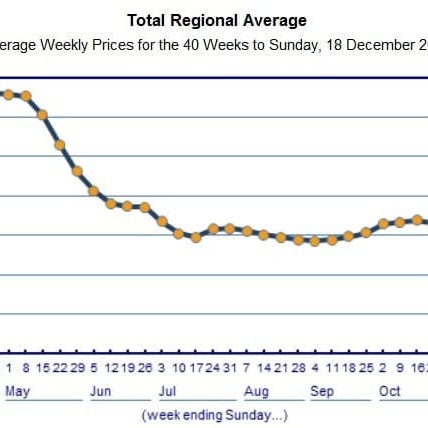 Diesel fuel prices in regional areas rose sharply during November and remained at higher levels through to the end of 2011, according to recent data released through the Australian Institute of Petroleum.
Diesel fuel prices in regional areas rose sharply during November and remained at higher levels through to the end of 2011, according to recent data released through the Australian Institute of Petroleum.
Variation in diesel prices can have a considerable impact of cost of production across the Australian beef industry, impacting on livestock transport, cost of shipping in live export, pumping stock water from underground sources and providing station electricity in more remote locations.
Large Northern cattle properties can easily accumulate costs of $50,000 a year in the provision of diesel-powered electricity for homestead, workshop and cold storage use alone.
The recent threat by Iran to close access to the Strait of Hormuz, a key shipping passage for oil transport, is the latest global issue to affect fuel pricing.
As the accompanying graph prepared by the Australian Institute of Petroleum shows, prices in regional areas of Australia are trending upwards again after a lengthy period of relative stability earlier last year.
The AIP diesel report for the week ending December 19 showed a national average retail diesel price in rural and regional (non-metropolitan) areas of Australia of 152.5c/litre, up 2.9c on the same time in November.
The price is calculated as a weighted average of retail diesel fuel prices for country regions in each State/Territory, where the weighting is based on the number of vehicles using diesel fuel. All values are in cents per litre and include GST.
Prices rose across all State and Territory regional/country areas, with Victoria and WA the worst hit, rising 1.9c/l and 1.8c/l respectively compared with the same time in November.
At a state-by-state level, regional diesel prices in the recent AIP report included:
- Victoria 150.1c/l (up 1.9c on November)
- NSW 152.3c (up 1.4c)
- Queensland 152.0c (up 1.3c)
- WA 156.5c (up 1.8)
- SA 151.6c (up 0.9c)
- TAS 153.8c (up 1.0c), and
- NT 164.6c (up only 0.3c, following a big rise the previous month).
As the graph shows, national prices reached a high-point around 157c/l in early April last year, before beginning to ease in June. This was around the time the A$ value softened off extreme levels above US109c and the second wave of concern emerged about the global economy.
Since then, prices remained fairly stable through to November, but then started to climb.
Crude oil, diesel and petrol prices are closely linked, as the price of crude oil accounts for the vast majority of the cost of producing a litre of petrol or diesel, the AIP says. Crude oil is purchased in US dollars, meaning that changes in the value of the A$ against the US$ has a direct impact on the relative price of crude oil in A$ terms.
Australia is only about 40pc self-sufficient in transport fuels.
Energy industry analysts say the renewed Euro zone debt crisis and higher fuel demand from China influenced fuel market sentiment in November/December.
Some analysts are predicting further rises in diesel and overall fuel prices in 2012, driven by expensive crude oil, political issues in some key oil producing regions in the Middle East and changes in refinery operations.
Last year, prices for petrol across the US reached a record high, averaging $3.514 a gallon. Already this year, petrol prices in parts of the US are up about 7c/l (33c/gal) compared with this time in 2011, adding further weight to US cost of living pressures.
This year's US gasoline prices could be significantly higher than in previous years, according to Tom Kloza, chief analyst for the US Oil Price Information Service.
He cited three potential causes: International worries about a second Arab Spring; domestic concerns about US refinery maintenance and the closure of at least two critical East Coast refineries.
In addition, driven by a low US currency value, US refiners have been exporting record amounts of diesel fuel as they pursue profits from foreign buyers – following a similar pattern as US beef exports last year. This has caused an increase in diesel production in US refineries at the expense of petrol production, tightening petrol supplies and causing prices to rise.
Crude oil prices are also starting the 2012 year on the move, another discouraging signal for petrol and diesel prices. The US benchmark grade of oil, West Texas Intermediate, remained above $100 a barrel in the three trading days of 2012 on concerns about Iran's threat to close the Strait of Hormuz.
The price eased a little on Thursday last week, falling 1.4pc to $101.81 on the New York Mercantile Exchange. In London, the European benchmark, Brent North Sea crude, also eased 0.8pc off recent highs, to A$110.74.
- Click on the image here for a better view of recent regional Australian diesel price trends.
